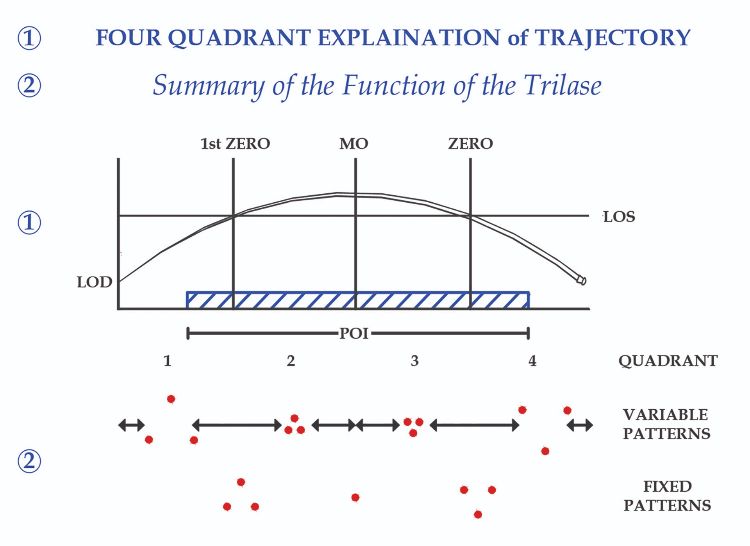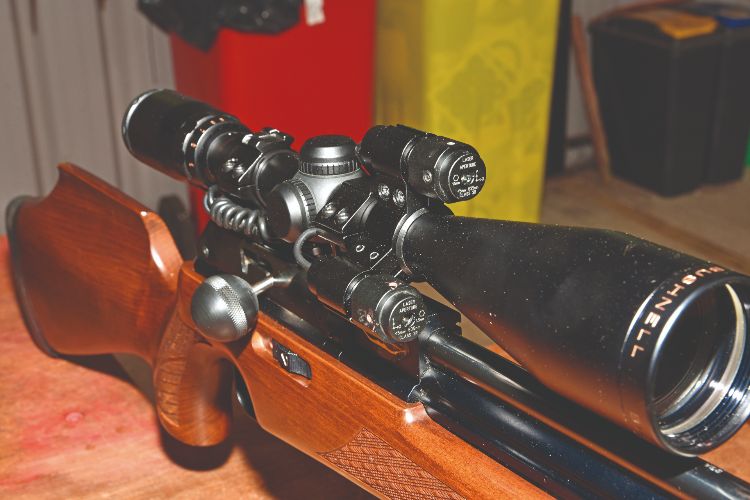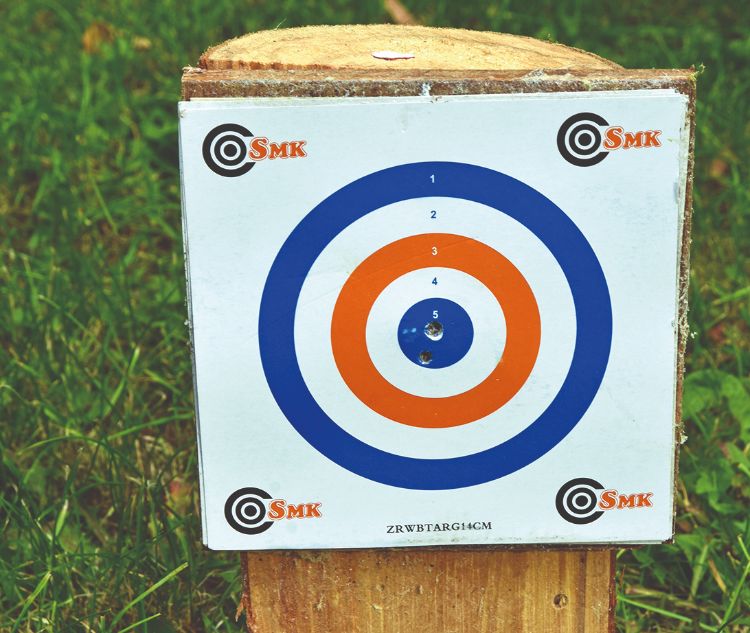Dave Barham gets to grips with an interesting scope bolt-on that allows you to determine range at the press of a button and aiding you in determining holdover.
Most airgunners will know that being able to determine the range at which your target sits is essential for accurate shooting. Whether you’re a hunter looking to shoot rabbits in a field, or a competition shooter aiming at knockdown targets on an FT or HFT course, we all need to know how far away our proposed target is. We can do this in a number of ways, namely by using a dedicated, hand-held laser rangefinder, or by working out distances using a compatible scope set-up. However, there’s a new, fun way of determining range that is the brainchild of Mark Rogers, creator of the Trilase system.
 Trajectory
Trajectory
When a pellet leaves the muzzle, it does not follow a straight line of flight like a laser, but instead follows trajectory, a bit like a ball that is thrown – first it goes up then it comes down. The path of an air rifle pellet is interesting in that it first travels upwards compared to the line of sight, then levels off horizontally, then begins to decline in altitude. The flight of the pellet or the trajectory path can be defined into four stages or ranges. This is the Four Quadrant Trajectory and it is helpful to explain how the Trilase is used to find the required compensation at any range.
First, the pellet moves out from the muzzle, technically known as the LOD – Line Of Discharge. This is often quite a bit below the LOS – the Line Of Sight. In the first quadrant of the trajectory, the shooter needs to use hold-over, decreasing to the first zero range. At the first zero range a shooter aims dead on. In the second quadrant hold-under is required, increasing to the highest point of the curve, technically called the 'maximum ordinate', where the pellet strikes highest on a target. In the third quadrant, the pellet begins to descend, but the shooter still applies hold-under, decreasing to the zero range. The zero range is the range at which the rifle is zeroed, often 30 metres or 33 yards. In the fourth quadrant, the pellet begins the descent so the shooter uses hold-over increasing in magnitude as the pellet gets further away from the shooter.
What is Trilase?
Trilase is a device that can be used by airgunners to judge and compensate for the effects of trajectory. The device uses triple lasers equally positioned around the line of sight of the scope. The lasers are activated by a pressure switch to produce a pattern of laser dots that are projected onto the target. The triple laser pattern will be viewed through the scope by the shooter before taking a shot.
Trilase can be used to gain knowledge of the compensation distance required for hold-over or hold-under of a target of unknown range. By viewing the laser pattern the Trilase shooter knows where the target lies on the path of the trajectory. It is immediately apparent which quadrant the target lies in based on the explanation above.
 How It Works
How It Works
The Trilase is calibrated with all three lasers intersecting to form a single dot, in the centre of the reticle of the pre-zeroed rifle scope on which the Trilase is mounted. I must mention at this point that currently, the Trilase is only available for 25mm-body scopes. The lasers are calibrated on a target at the range of the maximum ordinate. The maximum ordinate being the most significant point in any rifle trajectory.
Once this has been done, the Trilase, scope and rifle is nearly ready. The shooter first needs to know:
- The size of the upright laser pattern at the first zero range.
- The size of the upside-down laser pattern at the main zero range.
- The distance of trajectory hold-under at the maximum ordinate. These need to be learned.
I’m no technical wizard, but having these basic rules of thumb explained to me by Mark during our range day soon had me experimenting downrange, and it really didn’t take me very long to pick up the concept and start adjusting my hold-over and hold-under accordingly.
All you really need to work out is the distances between the dots and how they correlate to the amount of hold-over/-under is required. If an upright triangle pattern appears on a said target that is larger than the known laser pattern at the first zero range, then the target is in the first quadrant and the shooter needs to use hold-over. If the laser pattern on the target is smaller, then then the target lies in the second quadrant of the trajectory and the shooter needs to use hold-under. If a single dot is produced, the range is at the maximum ordinate and you aim dead centre.
Likewise, if an upside-down laser pattern is made that is smaller than the known laser pattern produced at the main zero range, then the target is in the third quadrant and the shooter needs to use hold-under. If the laser pattern is larger than the known laser pattern at the main zero range then it is in the fourth quadrant and the shooter needs to use hold-over.
When shooting flat with no extremes of environment, two general rules apply; if an upright triangle is present, the pellet is in ascent, and if an upside-down triangle is present the pellet is in descent. The larger the pattern, the greater the hold-over and in reverse, the smaller the laser pattern the greater the hold-under.
 More Experimentation
More Experimentation
I only had a couple of hours on the range with Mark, but he’d brought along two set-ups for me to try. The first being an FX Impact sub12 .177 and the second a BSA Super 10 FAC in .22. I quickly got to grips with both rifles and the Trilase system, and was hitting bullseyes consistently at varying ranges from 15 to 60 metres!
However, I think that some of the more technically minded airgunners out there could work out some correlation between the spread of the three laser dots in relation to a mil-dot reticle and come up with a simple formula for exactly how much hold-over/-under is required, in the blink of an eye. During the time I spent on the range, it was accurate guesswork on my part – I’d be more than happy with the results I was achieving if I hadn’t been using the Trilase! I’m quite certain that if I had the luxury of spending a few weeks with this system it would all become second nature to me, just like it has for Mark.
INFO
The Trilase system costs £155 and is available directly from Mark’s website